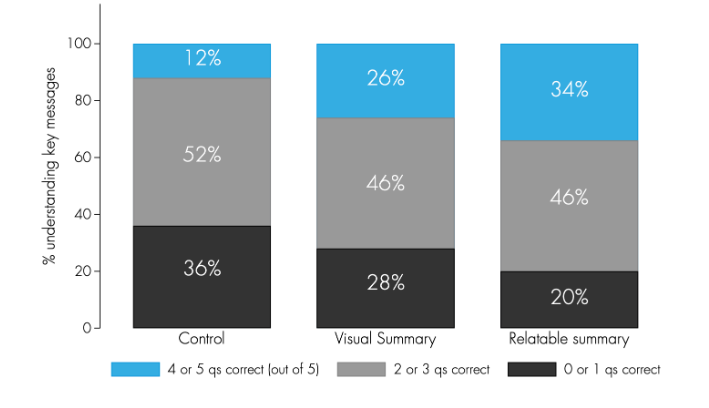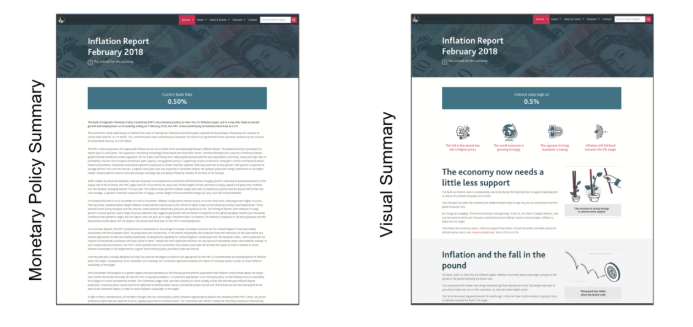The way public institutions like central banks communicate with the general public is important. What central banks say has a real effect on markets – for instance, the way the Bank of England communicates its Inflation Report affects long-run interest rates. At the same time, as argued by the Bank’s Chief Economist, Andy Haldane, there is a gap in public understanding and trust in economics and economic policymaking, which over the longer-term has the potential to undermine economic stability.
BIT and the Bank of England have been working on how to improve public trust in and understanding of the Bank’s activities. We focused on testing different ways of communicating the Bank’s quarterly Inflation Report (recently renamed the Monetary Policy Report) and the accompanying interest rate decision. The full results of our research have been published last week in the Journal of Monetary Economics.
Using our Predictiv online experimentation platform, we gave members of the public different versions of the Bank’s inflation report summary to read followed by a set of comprehension and trust measures.
If you want to have a guess predicting the results, or would like to see what other people predicted, go here.
The best performing summary

As set out in an earlier blog, a summary that made the material relatable was the most effective. The number of readers that understood most or all of the key messages nearly tripled compared to the business-as-usual Monetary Policy Summary. They were also better able to answer more applied comprehension questions – like working out what salary increase is needed to keep the same living standards if prices are rising at a certain rate. Finally, they were more likely to rate the information as trustworthy.
But, we were left with a range of questions on what was driving the effect – the length of the text, simplifying the language, use of visuals, or drawing parallels between economic statistics and the impact on someone’s daily life.
Disentangling what makes communication effective
So we ran a whole set of new experiments. This is what we found:
1. Reading grade is more important than visuals
Currently, the Bank publishes two summaries. There is a ‘Monetary Policy Summary’ that is relatively traditional and reflective of a lot of central bank communication – relatively complicated language with no visuals. Then there is a ‘Visual Summary’ that includes visuals alongside simplified language.
We took these two summaries, and then tested two other versions alongside them. We added visuals into the complex ‘Monetary Policy Summary’ and we took the visuals out of the ‘Visual Summary’.
We found that the visuals made no significant difference to comprehension. Instead, the main effect of the Visual Summary on comprehension came from its better readability score as measured by the Flesch-Kincaid grading system (available as part of many standard word processing packages). Even stripped of its visuals and holding the word count constant, the Visual Summary improved comprehension scores by around 15% compared to the Monetary Policy Summary.

2. Making the content relatable has an effect beyond simplifying the language
The Bank and BIT team co-developed a new ‘relatable’ summary that sought to make the information as relevant as possible to people’s daily lives – for instance relating the fall in the value of the pound to the cost of holidays abroad. The ‘Relatable Summary’ also used more first and second-person pronouns (‘you’ and ‘us’ rather than ‘the Bank’), used everyday words like ‘rising prices’ instead of ‘inflation’, and contained an interactive chart that showed unemployment by local area.
We tested this summary alongside a version of the Visual Summary with the same word count and readability score. Compared to this Visual Summary, the Relatable Summary improved comprehension scores by 19%.
What we’d like to do next
We think this provides a good starting point for economic institutions wanting to improve public comprehension and trust in what they do. But it’s also a first step. Some key questions that we think should be explored next are:
- Does better communication to the public affect actual consumer choices? Better understanding of inflation should change decisions on large purchases and wage negotiations among other things.
- Can we find ways of simply conveying harder concepts like the uncertainty in inflation and growth forecasts? There is emerging evidence on how best to do this but not much real-world testing so far.
- Does better communication filter through to better media reporting? TV, newspapers and social media are the ways in which most citizens will see information and messages from economic institutions – and is likely to determine overall understanding and trust.
You can read the full article, Enhancing central bank communications using simple and relatable information by David Bholat, Nida Broughton, Janna Ter Meer and Eryk Walczak in the Journal of Monetary Economics here.
If you’re interested in partnering with us on these ideas, please get in touch with Nida Broughton nida.broughton@bi.team.





